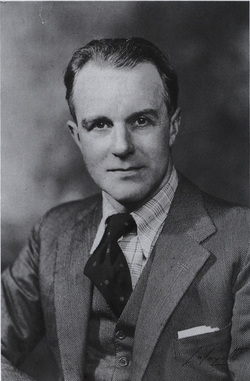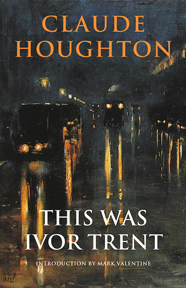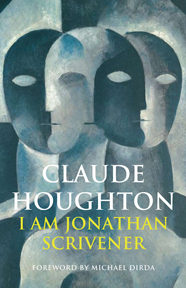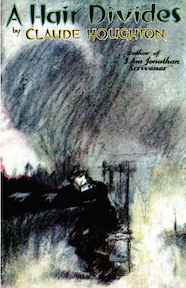|
BOOK DETAILS
Trade paper ISBN-13: 978-1941147085 List Price: $17.99 U.S. Pages: 186 Published: 2014 |
Neighbours (1926)
Claude Houghton With a new introduction by Mark Valentine Book Description
The narrator of Neighbours is a young writer who has taken a room in the attic of a lodging house, where he hopes to find a quiet atmosphere in which to work. One night, the sound of laughter outside his door alerts him to the existence of Victor, a fellow lodger in an adjoining room. The narrator feels an immediate and inexplicable hatred for his unwanted neighbour, which develops into an obsession as he listens to Victor’s fervent conversations and amorous adventures through the thin wall and records it all in minute detail on endless sheets of paper. His morbid fascination with Victor gradually begins to dominate his existence, leading to a shocking climax when he finally resolves to destroy his neighbour, the man he blames for ruining his life . . . Claude Houghton (1889-1961) won a devoted cult following in the 1930s with I Am Jonathan Scrivener (1930) and This Was Ivor Trent (1935), psychological thrillers with brilliantly sharp dialogue and unusual metaphysical themes. This edition of his astonishingly original first novel, Neighbours (1926), is the first in over 75 years and features a new introduction by Mark Valentine. |
reviews
“[G]rew upon me with every page, until I came to the dramatic climax … often brilliant … [with] the brilliance of fever, almost of delirium.” – Punch
“It is very shocking … [Houghton] has proved himself to possess considerable talent.” – Spectator
“Neighbours is a novel about ideas concerning life. It is full of dialogue, and good dialogue. It has beautiful moments. It is original.” – Arnold Bennett, Evening Standard
“In Claude Houghton’s work you have come to expect not only an unusual and fast-moving story, but one with its hidden excitements or seeming touch of fantasy, the significance of which may not be apparent until you have reached the last page.” – Sunday Times
“His novels bring us the finest and most firmly thought-out exposition of the spiritual problem of modern times.” – New York Times
“It is very shocking … [Houghton] has proved himself to possess considerable talent.” – Spectator
“Neighbours is a novel about ideas concerning life. It is full of dialogue, and good dialogue. It has beautiful moments. It is original.” – Arnold Bennett, Evening Standard
“In Claude Houghton’s work you have come to expect not only an unusual and fast-moving story, but one with its hidden excitements or seeming touch of fantasy, the significance of which may not be apparent until you have reached the last page.” – Sunday Times
“His novels bring us the finest and most firmly thought-out exposition of the spiritual problem of modern times.” – New York Times
ALSO AVAILABLE THROUGH ONLINE RETAILERS
MORE TITLES BY THIS AUTHOR
AUTHOR BIOGRAPHY

Claude Houghton Oldfield was born in 1889 in Sevenoaks, Kent and was educated at Dulwich College. He trained as an accountant and worked in the Admiralty in the First World War, rejected for active service by poor eyesight. In 1920 he married a West End actress, Dulcie Benson, and they lived in a cottage in the Chiltern Hills. To a writers’ directory, Houghton gave his hobbies as reading in bed, riding, visiting Devon and abroad, and talking to people different to himself. He added: “I like dawn, and the dead of night, in great cities.” He disliked fuss, noise, crowds, rows, and being misquoted, or being told how much he owed “to some writer I’ve never read”.
Houghton’s earliest writing was poetry and drama before turning to prose fiction with his first novel, Neighbours, in 1926. In the 1930s, Houghton published several well-received novels that met with solid sales and respectable reviews, including I Am Jonathan Scrivener (1930), easily his most popular and best-known work, Chaos Is Come Again (1932), Julian Grant Loses His Way (1933), This Was Ivor Trent (1935), Strangers (1938), and Hudson Rejoins the Herd (1939). Although he published nearly a dozen more novels throughout the 1940s and 1950s, most critics feel his later works are less significant than his novels of the 1930s.
Houghton was a prolific correspondent, generous in devoting his time to answering letters and signing copies for readers who enjoyed his books. One of these was novelist Henry Miller, who never met Houghton but began an impassioned epistolary exchange with him after being profoundly moved by his works. Houghton’s other admirers included his contemporaries P. G. Wodehouse, Clemence Dane, and Hugh Walpole. Houghton died in 1961.
Houghton’s earliest writing was poetry and drama before turning to prose fiction with his first novel, Neighbours, in 1926. In the 1930s, Houghton published several well-received novels that met with solid sales and respectable reviews, including I Am Jonathan Scrivener (1930), easily his most popular and best-known work, Chaos Is Come Again (1932), Julian Grant Loses His Way (1933), This Was Ivor Trent (1935), Strangers (1938), and Hudson Rejoins the Herd (1939). Although he published nearly a dozen more novels throughout the 1940s and 1950s, most critics feel his later works are less significant than his novels of the 1930s.
Houghton was a prolific correspondent, generous in devoting his time to answering letters and signing copies for readers who enjoyed his books. One of these was novelist Henry Miller, who never met Houghton but began an impassioned epistolary exchange with him after being profoundly moved by his works. Houghton’s other admirers included his contemporaries P. G. Wodehouse, Clemence Dane, and Hugh Walpole. Houghton died in 1961.





